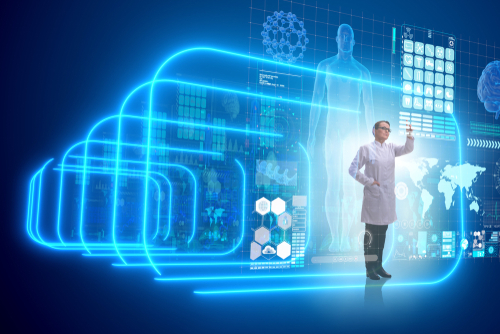



Get new exclusive access to healthcare business reports & breaking news




A new hybrid system of artificial intelligence (AI) and human scientists has shown it can achieve higher diagnostic accuracy than the humans or machine learning algorithms alone.
The technology called Swarm AI allows a “small group of doctors to be connected by intelligence algorithms that enable them to work together as a “hive mind,” a statement said. Swarm AI allows “networked groups to combine their individual insights in real-time, using AI algorithms to converge on optimal solutions.”
AI startup, Unanimous, the developers of Swarm AI, have been reportedly working for four years on showing that AI works better with the help of humans and presented its study at the 2018 SIIM Conference on Machine Intelligence in Medical Imaging.
The study tasked a group of experienced radiologists with diagnosing the presence of pneumonia in chest X-rays. The results showed that Unanimous’ technology diagnosed pneumonia 22 percent more accurately than a group of radiologists working individually and reduced errors by 33 percent.
Unanimous described the results of the study, which was carried out with the Stanford University School of Medicine, as exciting as it showed the “potential of AI technologies to amplify the accuracy of human practitioners while maintaining their direct participation in the diagnostic process.
The San Francisco-based startup said its technology was compared to the CheXNet system from Stanford University, which is considered the best system in the world for the automated diagnosing of pneumonia from chest X-rays.
“The Swarm AI system, which combines real-time human insights with AI technology, was 22 percent more accurate in binary classification than the software-only CheXNet system. In other words, by connecting a group of radiologists into a medical ‘hive mind’, the hybrid human-machine system was able to outperform individual human doctors as well as the state-of-the-art in deep-learning derived algorithms,” a statement said.
Accurately diagnosing pneumonia using chest X-rays is said to be very difficult, triggering interest from researchers working on AI technologies to make the process simpler. It is estimated that one million adults are diagnosed with pneumonia in the US annually.
Matthew Lungren, an Assistant Professor of Radiology at Stanford University, said the results of Unanimous’ AI point to a future “where doctors and AI algorithms can work together in real-time, rather than human practitioners being replaced by automated algorithms.”
Unanimous Chief Executive Officer and Chief Scientist, Louis Rosenberg said the study helped demonstrate how humans add value even in the world of AI. “We fundamentally believe that human wisdom, knowledge, and experience should never be fully replaced from critical decisions,” he said.
Unanimous said its Swarm AI technology connects networked groups of human participants into real-time intelligent systems modeled after swarms in nature, emulating the way birds flock, fish school, and bees swarm to amplify their collective intelligence. “The technology builds a ‘hive mind’ of networked participants, moderated by AI algorithms, to combine the group’s knowledge, wisdom, insights, and intuition into an optimized output,” the company said in a statement.
In explaining the hive concept, Rosenberg told Venturebeat that: “Animals use unique techniques they’ve evolved over millions of years with feedback loops that converge on an optimal combination of insights.”
On its Swarm AI, Unanimous works by allowing a group of radiologists to log onto its AI platform through networked computers. “Together, they then attempt to shift the cursor’s position towards a prediction [diagnosis] using a touchscreen, touchpad, or mouse. During this process, algorithms process the human participant’s behavior in real time,” the Algorithm-XLab website said.
The Spectrum website explained that each doctor controlled a small magnet icon that enabled them to push the group consensus towards their opinion, with each X-ray examined in real-time with the other doctors simultaneously contributing opinions.
“As the doctors weighed in, AI algorithms monitored the behavior of each participant, inferring how strongly each felt about their choice based on the relative motions of their icon over time. Someone who holds out longer on one choice, for example, may be expressing a stronger sentiment than someone who switches opinion quickly or several times,” the website said.
Using this system, the website said, the radiologists attained 82 percent total diagnostic accuracy in comparison to human experts, who only attained 73 percent accuracy.
Safwan Halabi, a clinical associate professor at Stanford University School of Medicine said the new technology “may enable us to generate more accurate datasets and increase the accuracy of all systems that use machine learning to train on medical datasets.”
Unanimous said its Swarm AI technology had the potential to generate more accurate “ground truth” datasets for the training of algorithmic systems like CheXNet, which could lead to future breakthroughs.
Ground truth is a term used in statistics and machine learning that means checking the results of machine learning for accuracy against the real world.
In its portfolio, Unanimous has Swarm AI, which won the AI Innovation of the Year award at the SXSW Innovation Awards this year and Swarm Intelligence.
Unanimous now plans to conduct a larger study using actual patient cases at the Stanford University Medical Center.
Interested in learning more about the best startups in pharma and healthtech? Check our guide to 31 best startups in 2018.